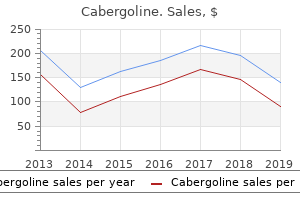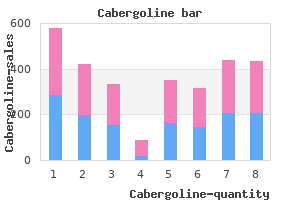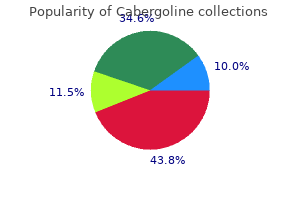


OLSSON'S IS CLOSED
Thank you to all our loyal customers who supported us for 36 years
"0.5mg cabergoline with mastercard, women's health clinic tucson".
By: O. Berek, M.A., M.D., Ph.D.
Assistant Professor, University of Florida College of Medicine
Monitoring of regional cerebral oxygenation by near-infrared spectroscopy during steady retrograde cerebral perfusion for aortic arch surgical procedure women's health issues in third world countries purchase cabergoline toronto. Experimental research on the impact of antegrade cerebral perfusion on brains with old cerebral infarction women's health center chicago cabergoline 0.25mg online. Consequently menstrual headaches symptoms cheap 0.5 mg cabergoline visa, a variety of adjunctive cerebral protecting techniques have been developed in an try and women's health center king of prussia pa buy cabergoline 0.25 mg without prescription enhance brain protection. A normal bicaval cannulation with caval snaring is adopted, with arterial return shown to the femoral artery on this case for schematic ease. The arterial cannula is clamped and the circuit drained into the bypass reservoir. It was then reported electively as a cerebral protecting approach by Lemole et al. These embody whether or not or not the method supplies brain perfusion, metabolic outcomes, histological and practical outcomes, results on cerebral embolization, cooling, and stress and circulate traits. Cerebral perfusion was measured using a laser Doppler flowmeter, and perfusion of the medulla was measured using a hydrogen clearance methodology. There was a big discrepancy between the 2 areas, with flow within the medulla being much like that of antegrade brain move, but cerebral cortex flow was much decrease at solely 16% of antegrade move values. Nojima and colleagues [16] also used maxillary vein cannulation in canine to demonstrate regional cerebral blood move utilizing a polarographic hydrogen-clearance method. These strategies are incapable of demonstrating precise brain capillary perfusion; because the retina is the one space where mind blood vessels could be instantly visualized, Dong et al. They managed to detect circulate in all retinal vessels, venous and arterial, thus providing direct evidence of true brain perfusion. This has been overcome by some authors by way of maxillary vein cannulation, though the clinical translation of that is questionable. Higher jugular venous pressures have been related to raised intracranial pressure. Histological results have been more complicated with some animals demonstrating very severe modifications, and some little or no histological harm. According to a pathological study on human cadavers by Dresser and McKinney [44], the overwhelming majority of internal jugular veins have venous valves, and these are typically competent. However despite this, latex was discovered within the superior sagittal and lateral venous sinuses and superficial cerebral hemisphere veins. They concluded that there was some venousarterial circulation however with solely limited circulate. In a large retrospective research of over seven-hundred sufferers, Hagl and colleagues [72] examined threat elements for stroke in a multivariate evaluation. This finding of a better incidence of transient neurological dysfunction was also reported by Okita et al. Body temperature influences regional tissue blood move throughout retrograde cerebral perfusion. Firstly, most authors have far too small a sequence for an appropriately powered examine to be carried out, and secondly, the check batteries used are sometimes difficult for sufferers present process such main surgical procedure to comply with. Retrograde cerebral perfusion utilizing pulsatile move underneath conditions of profound hypothermia. Regional cerebral tissue blood flow measured by the colored microsphere method throughout retrograde cerebral perfusion. A 31p-magnetic resonance research of antegrade and retrogade cerebral perfusion throughout aortic arch surgery in pigs. Retrograde cerebral perfusion during profound hypothermia and circulatory arrest in pigs. Retrograde cerebral perfusion with hypothermic blood offers environment friendly protection of the mind: a neuropathological examine. Cerebral safety during reasonable hypothermic circulatory arrest: histopathology and magnetic resonance spectroscopy of mind energetics and intracellular pH in pigs. Retrograde cerebral perfusion enhances cerebral protection throughout extended hypothermic circulatory arrest: a examine in a chronic porcine model.

Extreme attributions predict transition from melancholy to mania or hypomania in bipolar dysfunction menstrual like cramps at 32 weeks order discount cabergoline on-line. A double-blind menopause joint pain 0.25mg cabergoline mastercard, placebo-controlled examine with quetiapine as adjunct therapy with lithium or divalproex in bipolar I patients with coexisting alcohol dependence womens health expo cheap cabergoline 0.25 mg with mastercard. Suicide danger in placebo-controlled trials of remedy for acute manic episode and prevention of manic-depressive episode women's health clinic victoria hospital london on cheap cabergoline 0.5mg with amex. Efficacy and security of aripiprazole in subpopulations with acute manic or mixed episodes of bipolar I disorder. Comparison of two anticonvulsants in a randomized, single-blind treatment of hypomanic symptoms in patients with bipolar dysfunction. Treatment algorithm use to optimize administration of symptomatic sufferers with a history of mania. Clinical outcome in a randomized 1-year trial of clozapine versus treatment as traditional for patients with treatment-resistant illness and a history of mania. Rates of remission/euthymia with quetiapine in combination with lithium/divalproex for the treatment of acute mania. Differential impact of number of previous episodes of affective disorder on response to lithium or divalproex in acute mania. Mania: differential effects of earlier depressive and manic episodes on response to treatment. Exercise treatment for bipolar disorder: potential mechanisms of action mediated through elevated neurogenesis and decreased allostatic load. The impact of personalised guideline-concordant therapy on high quality of life and useful impairment in bipolar disorder. Early enchancment as a predictor of acute therapy consequence in manic or mixed episodes in bipolar-1 disorder: A pooled, submit hoc analysis from the asenapine improvement program. Effects of asenapine on depressive symptoms in sufferers with bipolar I dysfunction experiencing acute manic or blended episodes: a publish hoc analysis of two 3-week medical trials. The efficacy of cognitive-behavioral remedy in bipolar dysfunction: a quantitative meta-analysis. Outcomes for Latin American versus White patients affected by acute mania in a randomized, double-blind trial evaluating olanzapine and haloperidol. Effectiveness and security of the combination of fluoxetine and olanzapine in outpatients with bipolar despair: an open-label, randomized, flexible-dose examine in Puerto Rico. Level of response and security of pharmacological monotherapy within the treatment of acute bipolar I disorder phases: a scientific evaluation and meta-analysis. Comparative efficacy and acceptability of mood stabilizer and second technology antipsychotic monotherapy for acute mania-a systematic review and meta-analysis. Aripiprazole in bipolar depression: a pooled, post-hoc evaluation by severity of core depressive symptoms. Aripiprazole monotherapy in nonpsychotic bipolar I depression: results of two randomized, placebo-controlled research. Number needed to treat or hurt analyses of olanzapine for maintenance treatment of bipolar disorder. Maintenance of response following stabilization of combined index episodes with olanzapine monotherapy in a randomized, double-blind, placebo-controlled study of bipolar 1 dysfunction. A randomized, double-blind, placebo-controlled scientific trial of acamprosate in alcohol-dependent people with bipolar dysfunction: a preliminary report. Reversible elevation of triglycerides in dual-diagnosis patients taking aripiprazole: A case series. Efficacy of useful remediation in bipolar disorder: a multicenter randomized controlled research. Aripiprazole in the maintenance remedy of bipolar disorder: a important evaluate of the evidence and its dissemination into the scientific literature. Light therapy in the therapy of patients with bipolar despair: A meta-analytic examine. Variation in response to short-term antidepressant remedy between patients with continuous and non-continuous biking bipolar problems. Distressing cutaneous lesion amongst bipolar affective dysfunction patients on lithium therapy: A retrospective cross-sectional research. Retrospective analysis of therapeutic drug monitoring data for therapy of bipolar dysfunction with lamotrigine.
Discount cabergoline 0.5 mg with amex. What does the Quran really say about a Muslim woman's hijab? | Samina Ali | TEDxUniversityofNevada.

Increasingly pregnancy photos buy cheap cabergoline 0.25 mg online, empirical evidence helps disruption of particular neural circuits as a think about bipolar issues women's health issues in texas generic 0.25mg cabergoline with mastercard. However women's health nurse practitioner salary by state purchase cabergoline 0.25 mg overnight delivery, the exact mechanisms that lead to women's health & family services purchase 0.25 mg cabergoline with amex onset of bipolar problems are still not absolutely understood. Treatment Strategies Treatment generally begins with the objective of bringing a patient with mania, or disabling hypomania, or melancholy to symptomatic recovery and steady mood. Upon stabilization, upkeep treatment (both drug and nondrug options) goals to preserve euthymia (a nondepressed, reasonably optimistic mood), cut back any subthreshold symptoms (milder but nonetheless clinically important symptoms), and forestall or delay relapse into full-blown episodes of mania and depression. Questions stay as to whether treatment effects differ by affected person characteristics which may impression situation severity or treatment response. Drug therapies permitted by the Food and Drug Administration for bipolar treatment are summarized in Table 1. Given the continual, relapsing/remitting course of bipolar dysfunction and the necessity for maintenance remedy in many patients, medication begun for an acute mood episode (including mania) are sometimes carried forward as maintenance remedy. Some drugs that alleviate despair may improve the risk of mania, hypomania, or rapid cycling (four or extra episodes in 12 months), while some drugs that alleviate acute mania might increase the risk of rebound depressive episodes. All accredited medication have boxed warnings indicating severe or lifethreatening risks. Nonpharmacologic or psychotherapeutic techniques are applied to enhance medicine adherence, scale back episode relapse (maintenance), and improve social and occupational functioning, which are sometimes impaired during and after acute bipolar episodes. The majority of bipolar disorder-specific psychotherapeutic approaches have been studied in the last 15 years. These psychosocial approaches vary from psychoeducational, cognitive behavioral, and family-focused, to interpersonal social rhythm therapy, and are administered each individually and in teams. Most psychotherapeutic approaches focus the treatment for individuals at present in the remission state of bipolar sickness and infrequently particularly exclude individuals presently in acute manic episodes. They vary widely from electroconvulsive remedy to therapies for circadian rhythms, corresponding to mild packing containers, to acupuncture. Scope and Key Questions Several systematic evaluations have assessed the effects of bipolar disorder treatment. This review offers a complete up-to-date synthesis of the evidence on the effects of bipolar dysfunction remedies. How do pharmacologic therapies (monotherapy or combination therapies) have an effect on affected person centered outcomes compared with placebo How do pharmacologic treatments (monotherapy or mixture therapies) affect patient centered outcomes in comparison with different active pharmacologic remedy How do behavioral health therapies (psychotherapy, psychosocial interventions) affect affected person centered outcomes when compared with ordinary care How do behavioral health therapies (psychotherapy, psychosocial interventions, chronotherapy) have an result on affected person centered outcomes in comparison with other active therapy How do complete packages affect patient centered outcomes in comparison with traditional care Key Question 2: What are the harms from pharmacologic and nonpharmacologic treatments for adults with bipolar dysfunction Key Question four: Which patient traits predict the effectiveness and harms of pharmacologic and nonpharmacologic remedies for people with bipolar dysfunction, together with disease-specific traits such as bipolar sort, state severity, pediatric onset, new onset, remedy resistant, kinds of despair, and different comorbidities, and affected person characteristics similar to substance use, different psychiatric comorbidities, medical comorbidities, age, intercourse, race/ethnicity, socioeconomic standing Includes pregnant girls Excluded Pediatric patients with bipolar disorder Studies with samples of higher than 25% identified as schizoaffective dysfunction with bipolar �type symptoms. Schizoaffective disorder is distinguished by longer intervals of psychotic symptoms than bipolar dysfunction. Interventions to cut back side effects of medicines given for extended periods (metabolic syndrome, glucose dysregulation, weight gain) (such as verapamil, metformin) Drug therapy � placebo, active comparator Psychosocial or Somatic treatment � placebo/sham, ordinary care, or energetic comparator Comprehensive therapy � placebo or lively comparator Interventions � placebo, waitlist, active comparator, usual care Excluded Over-the-counter botanicals, dietary supplements, dietary approaches (including omega 3) Programs designed primarily as enhancing drug adherence. Thus, rather than organizing the report by Key Question, this report presents the profit and harms results organized by sort of therapy. The chapter presents benefits and harms for antipsychotics, each drug first as monotherapy, then, if current, together with temper stabilizers, followed by outcomes for temper stabilizers alone, and then other drugs. Chapter 5 presents benefits and harms for drug therapies for despair, Chapter 6 for maintenance treatment, and Chapter 7 for psychosocial therapies and different nondrug therapies. Since we had been unable to provide data on subpopulations, we provide tables with details of the handled populations for every intervention. An overall dialogue of themes chopping across all the chapters is offered in Chapter 8. Topic Refinement and Review Protocol this report topic and preliminary Key Questions arose by way of a public process. Our search strategy, which seems in Appendix A, included relevant medical subject headings and natural language phrases for the idea of bipolar dysfunction. We anticipated that older, established remedies can be lined by prior critiques, and we supplemented our searches with backward citation searches of related systematic critiques. We conducted additional grey literature searching to determine related accomplished and ongoing studies. Relevant grey literature sources embody trial registries and Food and Drug Administration databases. Grey literature search results have been used to identify studies, outcomes, and analyses not reported within the printed literature to assess publication and reporting bias and inform future analysis wants.

Contrast injection within the true lumen reveals the brachiocephalic vessels to be occluded by the dissection course of pregnancy risks over 40 buy generic cabergoline 0.25 mg on line. In the chronic part women's health center at huntington hospital purchase cabergoline mastercard, presentation may be with heart failure as a result of menopause 42 generic cabergoline 0.5mg with amex aortic regurgitation menstruation 2 weeks apart purchase cabergoline 0.5 mg, chest or again ache from the expanding aneurysm, a hoarse voice through recurrent laryngeal nerve palsy, or with dysphagia or stridor through mediastinal compression. The extent to which the dissection involves the arch and its branches could be extremely variable. Within the arch, the dissection involves a variable proportion of the aortic circumference. The dissection may stop at the origin of the arch branches leaving these undissected. Usually, all three brachiocephalic arteries come up from the true aortic lumen, with partial-circumference-dissection extending along their course to a variable extent. Rarely (but of particular surgical significance), the true lumen of one, two or all three brachiocephalic vessels is avulsed at their origins, offering re-entry at these sites. Despite the conceptual simplicity of this objective, the technique for reaching it safely and successfully in the arch could be very advanced. Two basic issues that need to be continuously stored in thoughts whereas planning and conducting aortic arch operations are introduced here and discussed intimately all through the remainder of the chapter. First, the surgeon needs to decide how a lot of the aorta will be replaced, and devise a plan for safely obtaining sufficient exposure to ccomplish the repair. For those who current with rupture, survival is the principal concern and the extent of aneurysm resection may be limited. As with all operations, adequate publicity of the complete extent of the pathology is paramount, until a two-stage procedure is deliberate. The arch itself is located throughout the superior mediastinum, but dissection surgical procedure invariably involves extension of the procedure to the ascending aorta, descending aorta, or both. Thus, a fastidiously deliberate strategy is required to cope with residual aortic root problems or intensive thoracoabdominal aneurysms which will not be totally accessible on the time of arch restore. Reoperation following previous acute ascending dissection restore provides extra challenges for publicity, notably these of a secure mediastinal re-entry and protection of important buildings such as the phrenic and recurrent laryngeal nerves. Pre-operative investigations the aims of the pre-operative investigations are to outline the extent and dimensions of the aneurysm and continual aortic dissection and to decide whether or not there are specific dangers associated with sternal re-entry or the perfusion techniques anti-cipated in the surgical plan. The information obtained from these scans can be reconstructed into both two- and three-dimensional photographs, permitting detailed evaluation of the extent of the dissection course of in regard to the aortic arch and visceral vessels, and exact analysis of all branches of the opacified aorta. This suboptimal procedure left the aortic sinuses and a regurgitant aortic valve in place. The dimensions of the aneurysm can be measured accurately to help decide the timing and extent of surgery. One limitation is the lack to assess aortic regurgitation, which might simply be accomplished with echocardiography. One kidney is supplied by the true lumen and is enhanced within the image; the other kidney is provided from the false lumen. The affected person had angina on exertion and was studied prior to extended aortic arch replacement. Angiography is in any other case indicated solely on uncommon events when individual facet branches of the aorta must be recognized (as within the case of the spinal radicular arteries). When to function on continual dissection arch aneurysms Many patients with persistent arch dissection are asymptomatic. The determination whether or not or not to resect an arch aneurysm involves the careful balance between the likelihood of rupture and the surgical risk in each individual. Once the diameter of the aneurysm reaches 5 cm, the expansion fee increases substantially, and is greater in people who smoke. The Yale group has proven that development rates enhance with aneurysm size and are be larger in the presence of continual dissection [6]. On the basis of detailed follow-up and 269 acquired photographs to the electrocardiogram, real-time cardiac imaging is obtained. If throughout a single six-month follow-up interval, the aneurysm has grown greater than 7 mm, then surgery is indicated, irrespective of the overall dimension.